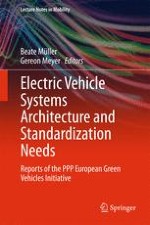This edited volume presents research results of the PPP European Green Vehicle Initiative (EGVI), focusing on Electric Vehicle Systems Architecture and Standardization Needs. The objectives of energy efficiency and zero emissions in road transportation imply a paradigm shift in the concept of the automobile regarding design, materials, and propulsion technology. A redesign of the electric and electronic architecture provides in many aspects additional potential for reaching these goals. At the same time, standardization within a broad range of features, components and systems is a key enabling factor for a successful market entry of the electric vehicle (EV). It would lower production cost, increase interoperability and compatibilities, and sustain market penetration. Hence, novel architectures and testing concepts and standardization approaches for the EV have been the topic of an expert workshop of the European Green Vehicles Initiative PPP. This book contains the contributions of current European research projects on EV architecture and an expert view on the status of EV standardization. The target audience primarily comprises researchers and experts in the field.
